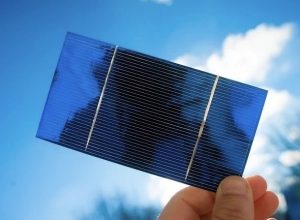APS Study Finds Specialized Chemicals Would Increase Efficiency of Solar Cells
Solar cells would increase in efficiency and durability if specialized chemicals were used in their manufacture, according to a paper published by a Department of Applied Physical Sciences professor and his colleagues in Nature Energy.
In the peer-reviewed article, “Ammonium Cations with High pKa in Perovskite Solar Cells for Improved High-Temperature Photostability,” Dr. Jinsong Huang, Louis D. Rubin, Jr. Distinguished Professor, explains that the chemical compounds phenethylamino methaniminium (PEAMA+) and butylamino methaniminium (BAMA+) help improve the efficiency of solar cells even after extended exposure to high temperatures and sunlight.
The solar cells with PEAMA+ resulted in improved performance and enhanced stability. After testing at 90 degrees Celsius, in which the compounds were exposed to simulated sunlight in a nitrogen atmosphere to eliminate the influence of atmospheric gases, the devices with PEAMA+ retained 90% of their initial efficiency after approximately 1,500 hours while the control devices demonstrated the same level of efficiency after only 800 hours.

By contrast, the organic chemicals phenethylammonium (PEA+) and butylammonium (BA+) commonly used in the manufacture of solar cells containing perovskite, a material with great light-absorbing and charging capacity, become unstable at 85 degrees Celsius, reducing the shelf life of the solar cells.
“When perovskites mixed with PEA+ and BA+ are exposed to high temperatures and light for an extended period, they can undergo changes,” said Huang, “which can reduce the stability of the perovskite material in solar cells. This reduced stability can be a problem for the long-term performance of the devices.”
Perovskite is also used in LED lighting, x-ray and gamma-ray detectors, sensors, superconductors and next-generation batteries and capacitors for energy storage.
In addition to PEAMA+ and BAMA+, the researchers found that formamidinium caesium (FAC) lead triiodide’s unique electronic and optoelectronic properties play a crucial role in improving the efficiency and stability of solar cells during exposure to light.
“FACs are a highly promising material for perovskite solar cells because of their ability to combine both high efficiency and improved stability, particularly in challenging conditions like high temperatures,” said Huang. “This combination of properties is crucial for the practical deployment of perovskite solar cell technology in real-world applications.”

APS professor Jinsong Huang, right, was joined in the research by APS research assistant and the paper's first author Mengru Wang (at the microscope).

